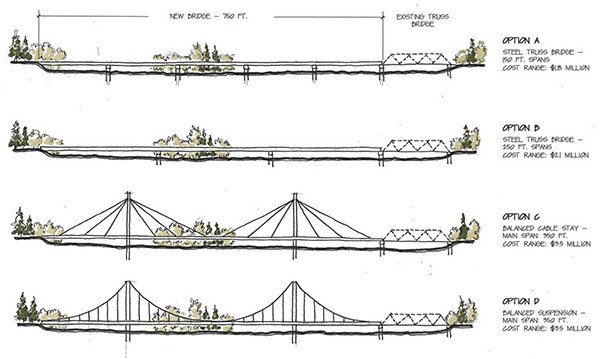With enough funding, a new “river-worthy” bridge will replace the damaged trestle at Railroad Bridge Park.
The trestle spanning the Dungeness River was damaged in early February when heavy rains that caused rapid currents, high flows and loose debris loosened piers holding up the trestle. Since then, the trestle — and the corresponding portion of the Olympic Discovery Trail — has been closed.
“If the river wants to go somewhere else, either the trestle isn’t going to let it or the river is going to take the trestle,” Randy Johnson, habitat program manager for the Jamestown S’Klallam Tribe, said.
Heightened river conditions negatively impacted the trestle, but the century-old, 150-foot bridge on the structure’s east end remains undamaged and will connect to another bridge aimed at replacing the trestle.
As owner of the park and its facilities, the Jamestown S’Klallam Tribe has taken the lead toward replacing the damaged trestle and reopening the trail.
“Whether we start with a temporary fix or can begin construction of a new bridge this year will depend on funding, expedited design and permits and on whether contractors will be available for this ambitious project,” Annette Nesse, chief operations officer for Jamestown S’Klallam Tribe, said.
Design under way
Tribal officials recently awarded Otak, an integrated architecture firm based in Redmond, the $172,000 design contract.
In pursuing one of their primary roles, which is to evaluate, prioritize and recommend local salmon recovery projects for public funding, a collaborative effort by members of the North Olympic Peninsula Lead Entity for Salmon helped to secure the design grant from the Salmon Recovery Funding Board, which operates under the state’s Recreation and Conservation Office.
The North Olympic Peninsula Lead Entity for Salmon is a locally based consortium of tribal and governmental entities, nonprofits and citizens that develop salmon habitat recovery strategies and then recruit organizations to do habitat protection and restoration projects that will implement the strategies.
The initial design by Otak combined input from experts from a wide range, Nesse said.
“The design we favor spans the new river channel with only two steel pilings, replacing more than 30 creosote pilings that held up the trestle but were never good for salmon protection,” she said.
The Dungeness River is “pinched” right where the trestle and bridge are located, Johnson told members of the Dungeness River Management Team. During a major rebuild of the trestle in the 1950s, engineers for the Milwaukee Railroad built up the west side of the river for the trestle.
Blocked by the fill, the river “blew through” the trestle in the 1960s, Johnson said. “It could not accommodate the river.”
Wanting to replace the trestle with a modern, river-friendly structure, the replacement is anticipated to improve spawning and rearing habitat for fish and rid the river of the 36 creosote piers.
The ideal design will be “river-worthy, salmon-friendly and serve the needs of the trail users,” Johnson said.
According to the preliminary design, the damaged 585-foot trestle would be replaced with a pedestrian bridge of about 750 feet.
The design is still a work in progress, but “it won’t be creosoted wood,” Johnson said. It will include fewer piers and removal of fill to allow for natural transport of sediment and wood, disperse high river flow and reduce the stream energy in the main channel — improving the stability of spawning habitat for salmon.
Other funding
In addition to the secured funding for the design phase, the tribe has committed $150,000 in insurance claim payments and $200,000 in tribal funds toward the project.
A remaining $1.8 million for construction still is pending, but the grant application for the project’s construction funds have ranked within the top three proposals, tribe officials said.
Although construction funds won’t be awarded until July and the state’s biennial budget takes effect, the $1.8 million was provisionally approved by the state’s Salmon Recovery Funding Board in early May, Cheryl Baumann, coordinator for the North Olympic Peninsula Lead Entity for Salmon, said.
Construction funding pends on the following: the project is recommended for funding by the North Olympic Peninsula Lead Entity for Salmon; the project and design are approved by the Salmon Recovery Funding Board’s technical review panel; and lastly, the approval of Salmon Recovery Funding Board grant dollars and Legislature’s approval of Puget Sound Acquisition and Restoration funds.
Sequim Gazette editor Michael Dashiell contributed to this report.
Reach Alana Linderoth at alinderoth@sequimgazette.com.



